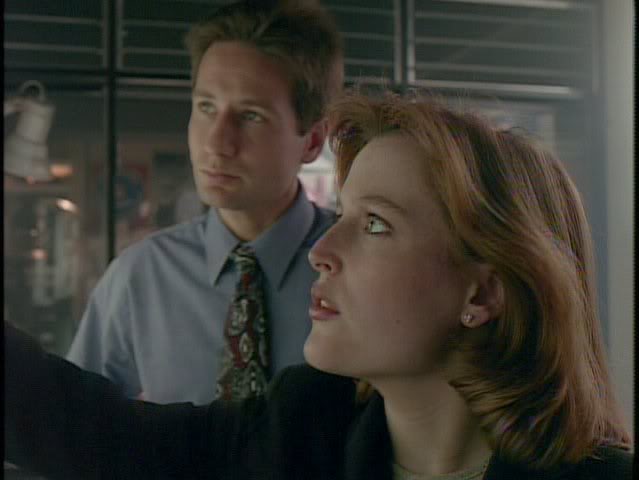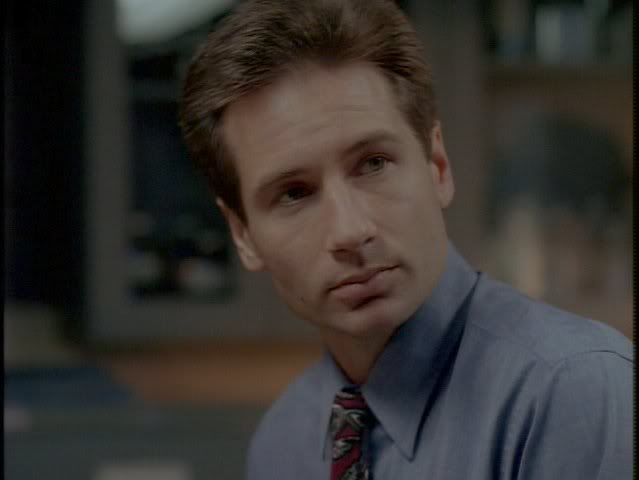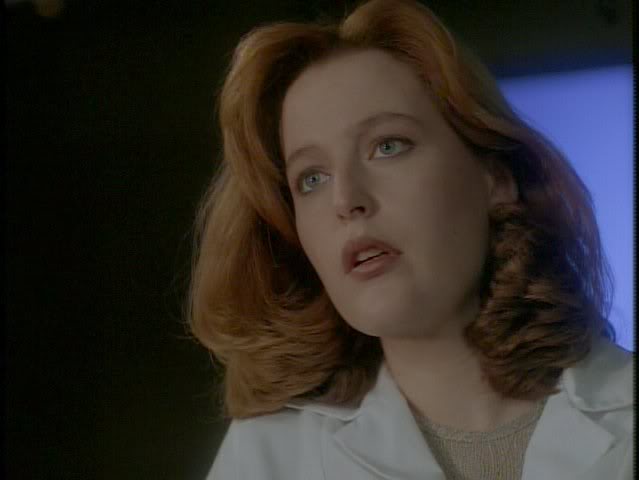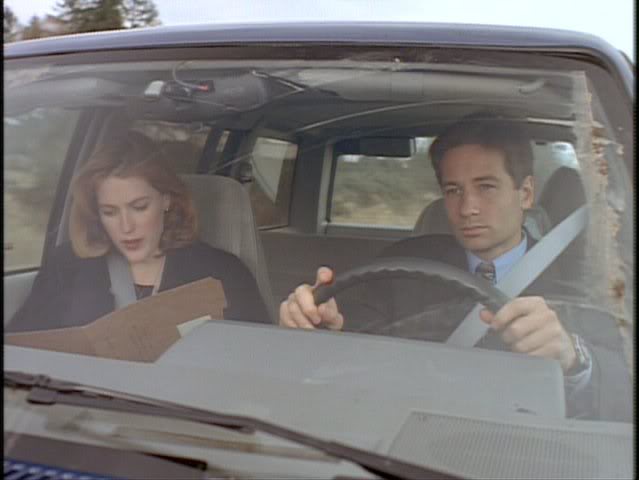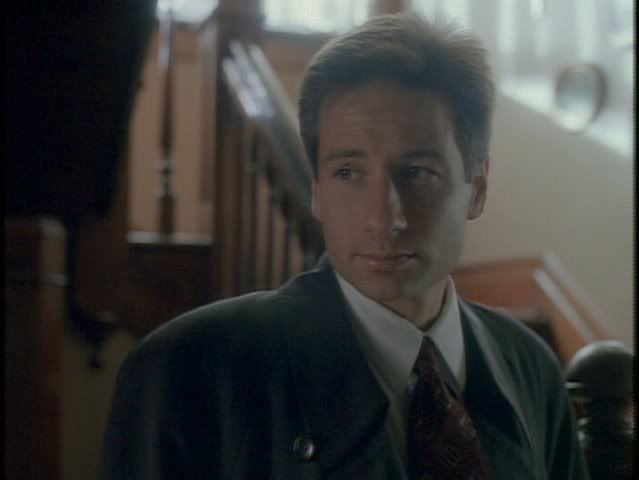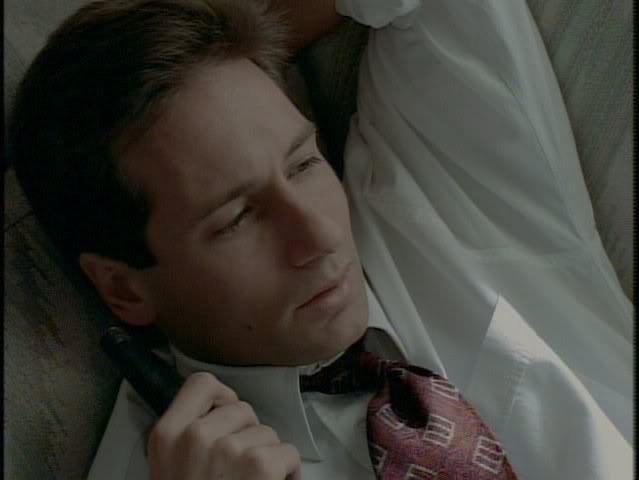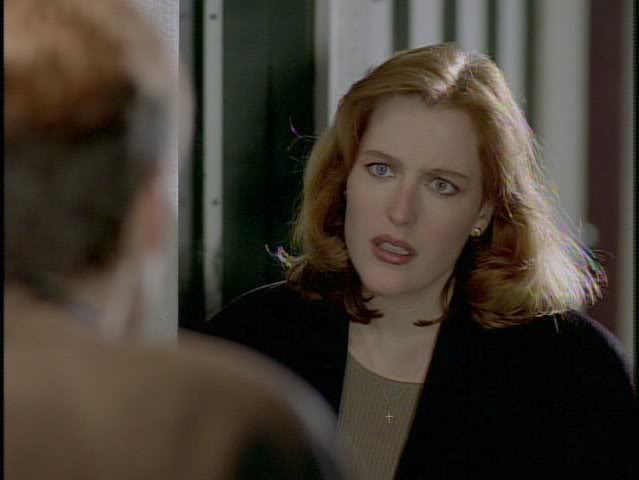CTP Episode of the Day - 12.05.06 – Aubrey
Today's Cherished Episode: Aubrey (2x12)
Original Air Date: January 6, 1995
Written By: Sara Charno
Directed By: Rob BowmanMulder and Scully investigate the possibility of genetic transferring of personality from one generation to another in connection with a serial killer.
M: "Well, that's a pretty extreme hunch."
S: "I seem to recall you having some pretty extreme hunches."
M: "I never have."Some "Aubrey" Tidbits & Musings:
-- Title: The episode is named for where it took place: Aubrey, Missouri.
-- "Aubrey" turned out to be a true team effort by the writing staff, as Sara Charno began with the concept of 50-year-old murders and the transfer of genetic memory, eventually combining that idea with a separate one she'd been mulling over about a female serial killer.
-- Sara Charno also wrote Season 2's "The Calusari." Charno was the wife of Stu Charno, who played the psychic killer in "Clyde Bruckman's Final Repose."
-- Certain changes were still being made right before shooting, such as the scene in the fourth act where Mulder was attacked by B.J., who as revised saw the face of the slain FBI agent from decades earlier when she looked at him.
-- Producers Glen Morgan and James Wong -- who provided numerous contributions to the script -- suggested casting Morgan Woodward in the role of Cokely, having remembered the veteran actor for an episode of 21 Jump Street he'd done while they were producing that series.
-- Woodward's credits also included the original Star Trek, Battle Beyond the Stars, and countless bad-guy roles in TV and movie Westerns. He holds the record for having done more guest starring roles on Gunsmoke (19) and Wagon Train (11) than any other actor. Woodward also had a recurring role on Dallas as Punk Anderson.
-- Terry O'Quinn has the distinction of playing three different X-Files related roles. He was Lt. Brian Tillman in "Aubrey," Darius Michaud in Fight the Future, and the Shadow Man in "Trust No 1." For some reason, he was credited as Terrance Quinn in the last one (it seemed to be a 2001/2002 thing). O'Quinn was a Chris Carter favorite, playing Peter Watts in Millennium and General Omar Santiago in Harsh Realm. O'Quinn was also a J.J. Abrams favorite, with recurring roles in Alias as FBI Assistant Director Kendall and currently in Lost as the mysterious John Locke.
-- Sarah-Jane Redmond (Young Mother) was also a Chris Carter favorite, playing Karin Matthews in Season 5's "Schizogeny," Lucy Butler in Millennium, and Inga Fossa in Harsh Realm.
-- The bones and skulls used in this episode and in "Our Town" were not real bones. They were plastic bones which were "aged" with paint and chemicals and had the plastic seams filed off. Using real bones would have cost a great deal more (not to mention the creep factor for cast and crew).
-- Mulder's fascination with women named B.J. might have had something to do with David Duchovny's then girlfriend, Perrey Reeves, who played a woman named B.J. on Doogie Howser.
-- Oopsie! When Scully was looking over the file on Agent Chaney, the shot over her shoulder showed the page turned over but from Mulder's point of view it was not.
-- Even before he was a 1013 employee, Vince Gilligan was obviously paying attention. Gilligan had Scully make reference to the line, "Well, I've often felt that dreams are answers to questions we haven't yet figured out how to ask," to Mulder in Season 4's "Paper Hearts."
-- Both Scully and Mulder appeared to have psychic connections in this episode. Scully "just knew" that B.J. and Tillman were having an affair and that B.J. was pregnant. And from a picture of a triangle and a circle, Mulder deduced the Trylon and Perisphere.
-- As Mulder said in the episode, the Trylon and Peripshere were symbols of the 1939 New York World's Fair, which was one of the largest world's fairs of all time. It was held at the current site of Flushing Meadows-Corona Park (also the site of the 1964 New York World's Fair). Many different countries around the world participated in it, and over 25 million people attended its exhibits.
-- The Trylon and the Perisphere were the central structures of the New York World's Fair. The Trylon, a triangular tower, measured 610 feet high and the Perisphere was a tremendous sphere, 180 feet in diameter. The two structures were connected by the Helicline (at the time the world's longest escalator). The sphere housed a diorama called "Democracity" which, in keeping with the fair's theme "The World of Tomorrow," depicted a utopian city-of-the-future. Democracity was viewed from above on a moving sidewalk, under movies displayed on the sides of the sphere. The Trylon and the Perisphere became symbols of the World's Fair, were reproduced on promotional materials, and served as the fairground's focal point.
-- In 1938, the New York Dodgers, Giants, and Yankees did their part to promote the upcoming fair with their jerseys. All players on those teams wore patches featuring the Trylon, Perisphere, and "1939" on their left sleeve.
-- The Trylon and Perisphere were designed by architects Wallace Harrison and J. Andre Fouilhoux, with the interior exhibit by Henry Dreyfuss. The structures were originally built in Flushing Meadows in Queens, New York, but both structures were subsequently razed and scrapped for use in World War II armaments.
-- The concept of the Perisphere was revisited in the later 1964/65 New York World's Fair with the Unisphere, as well as with Spaceship Earth at Epcot in Walt Disney World.
-- Almost an Oopsie! As Mulder and Scully headed down the stairs behind B.J. as she was digging up the second body under the floorboards, Gillian Anderson took a misstep and almost fell down the stairs. David Duchovny put his hand out to steady her.
-- Harry Cokely's home was used as a location again -- as the Peacock House in "Home." The house was actually located in South Surrey, near the U.S./Canadian border.
-- Mrs. Thibedeaux's staircase made an appearance in several X-Files episodes, most notably "Wetwired" (where Mulder and Mr. X had their showdown).
-- Mrs. Thiibedeaux told Mulder and Scully that Cokely's baby that she gave up for adoption would be 50 years old now, meaning the offspring from that child would be in his/her early 30s at the most. Deborah Strang did a fine job as B.J. Morrow, but she appeared a bit long in the tooth to be playing that part.
-- The mysterious Mulder and Scully go-to guy Danny had another non-appearance in "Aubrey" -- but he did have a last name: Valladeo. "Danny's" last name in Season 1's "Conduit" was "Bernstein."
-- Scully's line, "I don't think Mendel had serial killers in mind when he developed his theory on genetics," referred to Gregor Mendel, a 19th century Austrian monk who is considered the father of genetics. Through a study of more than 28,000 pea plants between 1856 and 1863, he discovered that there was a particulate inheritance of traits that follow certain rules. His generalizations later became known as Mendel's Laws of Heredity or Mendelian inheritance. The meaning of his discovery was only fully comprehended at the turn of the 20th century.
-- "Aubrey" provided X-Philes with insight on why Mulder liked sunflower seeds -- because his father did. Mulder also mentioned in this episode that "when I was a kid, I would have nightmares"; and a popular fanfiction plot device was born.
-- Mulder's line, "Jung wrote about it when he talked about the collective unconscious. It's genetic memory, Scully," referred to Carl Jung (1875 - 1961), Swiss psychiatrist considered the founder of analytical psychology. The collective unconscious referred to that part of a person's unconscious which was common to all human beings. It contained archetypes, which were forms or symbols that were manifested by all people in all cultures. They are said to exist prior to experience, and are in this sense instinctual. Jung believed that one could understand the psyche through an extensive analysis of dreams, art, mythology, religion, and philosophy. The collective unconscious is also known as "a reservoir of the experiences of our species."
-- The movie that Cokely was watching when B.J. came into his home was "His Girl Friday" (1940) which was based on the stage play, "The Front Page." Cary Grant was a newspaper editor, Walter Burns, trying to prevent his ace reporter ex-wife Hildy Johnson (Rosalind Russell) from remarrying and leading a "normal" life. He used every trick possible to do that. The big story in the film was an upcoming execution of a mild-mannered little man whom many believe was innocent of the murder of which he was convicted, and the political corruption of the officials involved. Every reporter was trying to get a scoop on the action surrounding this big story. This was to be Russell's last story before marriage and retirement, and Grant pulled out all the stops trying to mess things up for her, even to giving her counterfeit money. There was a jailbreak, shooting, and a hilarious scene where Russell chased a man down and tackled him in her high heels! Of course, Grant and Russell were reunited at the last, and we hoped that it would be happily ever after -- much as we did for another couple.
-- Once & Future Retreads: In addition to Terry O'Quinn and Sarah-Jane Redmond, Robyn Driscoll (Detective Joe Darnell) was a Technician in "Lazarus."
(Thanks to chrisnu for today's pics.)
Please share your first impressions, favorite (or cringe-worthy) moments, classic lines, favorite fanfic, nagging questions, repeated viewing observations, etc., as today we celebrate "Aubrey."
Polly
